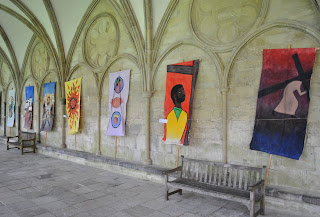
Today we had a tour of the Barbican Library, the largest public library in the City of London. I should say, though, that the City of London proper is only a small part of the large metropolitan area that makes up what you would normally think of as "London"--those of you back home in Los Angeles will understand what this means if you think of how West Hollywood, Santa Monica, and Beverly Hills all have their own separate city governments and library systems.
There are only a few thousand residents of the City, so much of the library's base of users are people that come into the City to work during the day, and students at nearby arts and music schools. This means that library's strengths are in its business and arts collections. It has an extensive sheet music collection, and the librarians have created a specialized index to help people find particular songs within sheet music anthologies. The library has an electric piano available for patron use (with headphones, for the sake of the other patrons). Although the original idea was that it would be a handy way for patrons to try out sheet music to make sure they had picked the right piece, it is mostly used for people who want to practice the piano. The music librarian told us that they have seen children go from beginning learning to progress through their qualification exams, without having a piano at home because they have this resource available to them. It's something the library is justifiably proud of. They also run Music Preserved, an archive of live performances.
It was fascinating to see the similarities and subtle differences between librarianship in the United States and England. I was happy to see that patron privacy is as much of a concern here as it is back in the US. Although the books are RFID tagged for easy check-out on the library's machines, a deliberate choice was made not to tag patron library cards because of privacy concerns. Cards also do not have photos on them, and no photo ID is required to get a card--it's very much on the honor system. The idea of the 24-7 library and a push for greater incorporation of digital resources is also very much alive here. The library has a number of databases that patrons can access at home, and they can access the catalog, including taking care of things like renewals and hold requests from home.
One small difference is that there are charges to check out non-educational DVDs and CDs. A larger difference is that age restrictions on what DVDs can be checked out are actually enforced; according to the librarians, the library is required to do so under UK law. (You can check out more about the British film classification system here.) Similarly, the internet on a lot (but not all) of the library's computers is filtered, and I didn't get the impression that this was as controversial for librarians here as it is for librarians in the US. (Though, in the US, a look at the number of state laws shows that it might be more mainstream than I think it is. It's also worth noting that in Washington state, filtering is surviving legal challenge at the moment.)
Another big difference is the amazing Bookstart program. Under this program, every child in the UK is entitled to a packet of free books at three points in their childhood--before the age of 1, at 18 to 30 months, and at 3-4 years of age. According to the children's librarian we met, this program was started by a woman who saw a child of four who had no idea what to do with a book when it was given to him. She became deeply upset when she realized that there were some children who simply had no access to books in the home. This relatively small, probably not very expensive program has real impacts on reading behavior. It would be wonderful if we could get something similar going in the US, but I have an unfortunate feeling that our politics would never let something like this get off the ground.
Finally, I was impressed by the level of attention that the library pays to making sure that there is access to materials for disabled patrons--something that we try to do in the US, though we don't always succeed. There are, of course, large print materials; there is also an enlarger available for books that do not come in large print, a JAWS screen reader station, and a dedicated internet workstation for persons in wheelchairs. The library even makes home deliveries to those that can't make it to the library, and has staff dedicated to working with the home delivery patrons on what materials they would like to use.























































